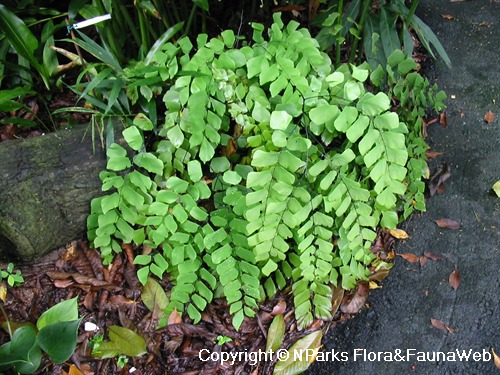.jpg)
Back
Adiantum raddianum C. Presl
| Family Name: | Pteridaceae |
| Synonyms: | Adiantum cuneatum |
| Common Name: | Delta Maidenhair Fern |
Name
Classifications and Characteristics
| Plant Division | Ferns & Lycophytes (Non-Seed Vascular Plants) (Fern) |
|---|---|
| Plant Growth Form | Shrub, Creeper |
| Mode of Nutrition | Autotrophic |
| Maximum Height | 0.3 m to 0.6 m |
Biogeography
| Native Distribution | Mexico to Tropical America |
|---|---|
| Native Habitat | Terrestrial |
| Preferred Climate Zone | Tropical |
| Local Conservation Status | Non-native |
Description and Ethnobotany
| Growth Form | Terrestrial plant up to 0.6m tall. It has short rhizomes with pointed dark brown scales. |
|---|---|
| Foliage | Petioles are glabrous, dark reddish, in bundles approximately 9.5-33cm in length, scales present at the base. Fronds are tripinnate, measuring 9.5-33 × 4.5-22cm. 7-13 pairs of leaflets, fan-shaped, light green but darkens with age. Leaflets have a cuneate base, rounded and wavy margin. It measures up to 1cm wide. Numerous spore cases, very small in size surrounded by a pale or whitish kidney-shaped membrane. |
| Taxonomy | The genus was derived from the Greek word – adiantos which meant unwetted, referring to its water repellant foliage. The specific epithet is named after Italian botanist Giuseppe Raddi. |
Landscaping Features
| Desirable Plant Features | Ornamental Foliage |
|---|---|
| Landscape Uses | Interiorscape/ Indoor Plant, Container Planting, Suitable for Hanging Baskets |
Plant Care and Propagation
| Light Preference | Semi-Shade |
|---|---|
| Water Preference | Moderate Water |
| Plant Growth Rate | Moderate |
Foliar
| Mature Foliage Colour(s) | Green |
|---|
Non - Foliar and Storage
| Specialised Storage Organ(s) | Underground |
|---|
Image Repository
Others
| Master ID | 29188 |
|---|---|
| Species ID | 3497 |
| Flora Disclaimer | The information in this website has been compiled from reliable sources, such as reference works on medicinal plants. It is not a substitute for medical advice or treatment and NParks does not purport to provide any medical advice. Readers should always consult his/her physician before using or consuming a plant for medicinal purposes. |

.jpg)



